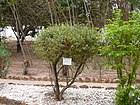Note: This is a project under development. The articles on this wiki are just being initiated and broadly incomplete. You can Help creating new pages.
Difference between revisions of "Lawsonia inermis - Mendhika"
| Line 1: | Line 1: | ||
[[File:Lawsonia inermis (Mehndi) in Hyderabad, AP W IMG 0528.jpg|thumb|right|''Henna/Mehdi'']] | [[File:Lawsonia inermis (Mehndi) in Hyderabad, AP W IMG 0528.jpg|thumb|right|''Henna/Mehdi'']] | ||
| − | '''Henna''' is a flowering plant and the sole species of the Lawsonia genus. It is a heavily-scented, much-branched, slender, evergreen shrub or small tree. It usually grows up to 6 metres tall | + | '''Henna''' is a flowering plant and the sole species of the Lawsonia genus. It is a heavily-scented, much-branched, slender, evergreen shrub or small tree. It usually grows up to 6 metres tall. <ref name="Plant family"/> |
==Uses== | ==Uses== | ||
{{Uses|Bleeding}}, {{Uses|Nerve deseases}}, {{Uses|Amoebic dysentery}}, {{Uses|Wounds}}, {{Uses|Skin eruptions}}, {{Uses|Ulcers}}, {{Uses|Pimples}}, {{Uses|Diarrhea}}, {{Uses|Sore throats}}. | {{Uses|Bleeding}}, {{Uses|Nerve deseases}}, {{Uses|Amoebic dysentery}}, {{Uses|Wounds}}, {{Uses|Skin eruptions}}, {{Uses|Ulcers}}, {{Uses|Pimples}}, {{Uses|Diarrhea}}, {{Uses|Sore throats}}. | ||
Latest revision as of 12:40, 5 June 2023
Henna is a flowering plant and the sole species of the Lawsonia genus. It is a heavily-scented, much-branched, slender, evergreen shrub or small tree. It usually grows up to 6 metres tall. [1]
Contents
- 1 Uses
- 2 Parts Used
- 3 Chemical Composition
- 4 Common names
- 5 Properties
- 6 Habit
- 7 Identification
- 8 List of Ayurvedic medicine in which the herb is used
- 9 Where to get the saplings
- 10 Mode of Propagation
- 11 How to plant/cultivate
- 12 Commonly seen growing in areas
- 13 Photo Gallery
- 14 References
- 15 External Links
Uses
Bleeding, Nerve deseases, Amoebic dysentery, Wounds, Skin eruptions, Ulcers, Pimples, Diarrhea, Sore throats.
Parts Used
Chemical Composition
The major components were ethyl hexadecanoate (24.4%), (E)-methyl cinnamate (11.4%), isocaryophyllene (8.1%), (E)-β-ionone (5.8%) and methyl linolenate (4.1%).[2]
Common names
| Language | Common name |
|---|---|
| Kannada | Goranta, Gorante |
| Hindi | Hena |
| Malayalam | Mail-anschi, Mailanci |
| Tamil | Aivanam, Aivanam |
| Telugu | Goranta, Gorata |
| Marathi | NA |
| Gujarathi | NA |
| Punjabi | NA |
| Kashmiri | NA |
| Sanskrit | Dvivranta, Kokadanta |
| English | Henna |
Properties
Reference: Dravya - Substance, Rasa - Taste, Guna - Qualities, Veerya - Potency, Vipaka - Post-digesion effect, Karma - Pharmacological activity, Prabhava - Therepeutics.
Dravya
Rasa
Guna
Veerya
Vipaka
Karma
Prabhava
Habit
Identification
Leaf
| Kind | Shape | Feature |
|---|---|---|
| Simple | Henna is a thorny evergreen shrub that can reach up to 6.0 m in heightThe leaves are divided into 3-6 toothed leaflets, with smaller leaflets in between |
Flower
| Type | Size | Color and composition | Stamen | More information |
|---|---|---|---|---|
| Unisexual | 2-4cm long | Yellow | 5-20 | The fragrant flowers are whitish or pink to brick red and sit in a pyramid-shaped inflorescence |
Fruit
| Type | Size | Mass | Appearance | Seeds | More information |
|---|---|---|---|---|---|
| Simple | 7–10 mm | The fruit is a blue-black berry | Single | {{{6}}} |
Other features
List of Ayurvedic medicine in which the herb is used
Where to get the saplings
Mode of Propagation
How to plant/cultivate
Seed - germinates best at temperatures around 25°c. Because of their hard seedcoats, the seeds have to be pre-germinated before sowing.[5]
Commonly seen growing in areas
Warmer parts of South and North America, Meadows, Borders of forests and fields.
Photo Gallery
References
- ↑ Karnataka Aushadhiya Sasyagalu By Dr.Maagadi R Gurudeva, Page no:127
- ↑ Chemical constituents
- ↑ Plant description
- ↑ Ayurvedic preparations
- ↑ Cultivation Details
External Links
- Ayurvedic Herbs known to be helpful to treat Bleeding
- Ayurvedic Herbs known to be helpful to treat Nerve deseases
- Ayurvedic Herbs known to be helpful to treat Amoebic dysentery
- Ayurvedic Herbs known to be helpful to treat Wounds
- Ayurvedic Herbs known to be helpful to treat Skin eruptions
- Ayurvedic Herbs known to be helpful to treat Ulcers
- Ayurvedic Herbs known to be helpful to treat Pimples
- Ayurvedic Herbs known to be helpful to treat Diarrhea
- Ayurvedic Herbs known to be helpful to treat Sore throats
- Herbs with Leaves used in medicine
- Herbs with Seeds used in medicine
- Herbs with common name in Kannada
- Herbs with common name in Hindi
- Herbs with common name in Malayalam
- Herbs with common name in Tamil
- Herbs with common name in Telugu
- Herbs with common name in Sanskrit
- Herbs with common name in English
- Habit - Evergreen shrub
- Index of Plants which can be propagated by Cuttings
- Index of Plants which can be propagated by Seeds
- Herbs that are commonly seen in the region of Warmer parts of South and North America
- Herbs that are commonly seen in the region of Meadows
- Herbs that are commonly seen in the region of Borders of forests and fields
- Herbs
- Ayurvedic herbs that don't have flower, fruit and leaf photos
- Ayurvedic herbs that don't have seed photos
- Lythraceae




